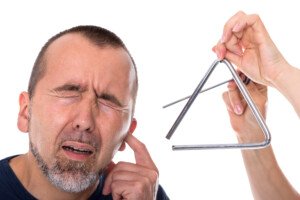
TMJ disorder can cause tinnitus, but what does this tinnitus sound like?
Tinnitus has been described as being many different kinds of sounds that a person subjectively “hears” inside their ears.
“There are many different intensities and forms of ringing in the ears (known as tinnitus),” says Jeffrey Haddad, DDS, of Doolin Haddad Advanced Dentistry in Rochester, MI.
“In fact, there are many sounds and feelings that people experience when it comes to ear symptoms, especially when related to a TMJ disorder.
“One of the most common issues people experience as a result of a TMJ disorder can be ear symptoms.”
Ear Symptoms Caused by TMJ Disorder
• Ear ringing (tinnitus)
• Ear congestion and fullness
• Sharp or dull ear pain
• “Swooshing” sound in ear
• Perceived or actual hearing loss
• Vertigo (dizziness) sounds in ear caused by tmj
Dr. Haddad continues, “These ear symptoms can occur bilaterally [both sides] or unilaterally [one side], depending on the specific mandibular jaw posture and condylar position in the glenoid fossa.
“The more compression of the vital TMJ structures including the articular disc, retrodiscal tissue and the interrelated ligaments, nerves and blood vessels in the area, the more dysfunction will occur.
“Over the past 15 years, the majority of my TMJ patients have tinnitus (ringing in the ears) as one of their symptoms. Sometimes it’s the main symptom they’re are experiencing; sometimes it is a minor one.”
What Does the Tinnitus of TMJ Disorder Sound Like?
“I have had patients state that they cannot go to restaurants or parties because the ringing in their ears is so intense that the additional outside noise drives them crazy,” says Dr. Haddad.
“I have also had patients who are suffering from intense migraine headaches and vertigo, but have a low ringing in one or both ears (something that is not even a concern for them).
“No TMJ patient is the same. They all experience their symptoms at differing intensities, intervals and accommodate to the best of their body’s ability.
“Therefore, it is more important for a diagnosing doctor to identify the consistent clinical signs of a TMJ disorder, treat their patients with a conservative and predictable approach, and let the patient’s body respond at its own pace.”
The sounds in the ear that TMJ disorder can cause include a swooshing or whooshing noise, the sound of blood flowing, or a hissing, buzzing or fizzing, which may be of a very high pitch.

Dr. Haddad lectures nationally on cosmetic dentistry, TMJ disorders and practice marketing, and utilizes the latest technology to ensure the utmost in patient comfort and care.
 Lorra Garrick has been covering medical, fitness and cybersecurity topics for many years, having written thousands of articles for print magazines and websites, including as a ghostwriter. She’s also a former ACE-certified personal trainer.
Lorra Garrick has been covering medical, fitness and cybersecurity topics for many years, having written thousands of articles for print magazines and websites, including as a ghostwriter. She’s also a former ACE-certified personal trainer.
.











